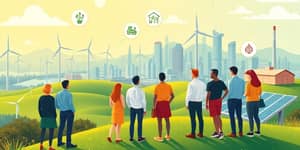The linear model of economic growth—extracting resources, producing goods, and discarding waste—has driven unprecedented prosperity, but at a staggering environmental cost. Today, resource scarcity, climate disruption, and biodiversity loss demand a fundamental shift in how we create, consume, and discard. The take-make-waste economy is no longer sustainable. To address these challenges, the circular economy emerges as a transformative model, offering both ecological restoration and resilient growth.
In this article, we explore the concept, principles, and urgent relevance of the circular economy. You will discover practical strategies for businesses and individuals to adopt circular practices, understand economic and social benefits, and learn how to overcome implementation barriers. By the end, you will feel empowered to contribute to a regenerative, prosperous future.
Definition and Contrast with the Linear Model
The circular economy is an economic model focused on sharing leasing reusing repairing materials and products for as long as possible. It removes the notion of waste by designing products and systems where every component can be repurposed, refurbished, or recycled.
In contrast, the linear approach treats materials as disposable. Raw resources are extracted, processed into goods, and ultimately become waste in landfills or incinerators. The circular model closes this loop, keeping materials in circulation and allowing nature to regenerate.
Core Principles Driving Circularity
Central to the circular economy are three guiding principles, often summarized as the "3Rs":
- Eliminate waste and pollution: Design products and processes to prevent waste at every stage, from sourcing to end of life.
- Circulate materials and products: Maintain the highest value of resources through reuse, repair, refurbishment, remanufacture, and recycling.
- Regenerate natural systems: Restore ecosystems by using renewable energy and materials, and return biological resources to the environment.
These principles work together to decouple economic growth from resource consumption, fostering systems that are both productive and restorative.
How Businesses Implement Circular Practices
Companies worldwide are embracing circular business models to reduce costs, access new markets, and enhance resilience. Key strategies include:
- Designing for durability and reparability: Products are engineered to last longer and be easily repaired or upgraded, reducing the need for replacements.
- Product-as-a-service models: Instead of selling goods outright, businesses lease or share products, maintaining ownership and responsibility for maintenance.
- Refurbishing and remanufacturing: Used items, especially electronics and appliances, are restored to like-new condition, extending their useful life.
- Upcycling and innovative recycling: Agricultural waste becomes bio-based plastics, and textile offcuts are transformed into new fashion items.
By rethinking value chains and prioritizing longevity, companies not only reduce environmental impact but also tap into new revenue streams and strengthen consumer loyalty.
Economic, Environmental, and Social Benefits
Adopting circular practices delivers multidimensional benefits, from direct cost savings to broader societal gains. Consider this overview:
On the social front, circular economy initiatives often spur community-based repair workshops, skill development programs, and collaborative partnerships between businesses, governments, and nonprofits. These efforts enhance local economies and foster social cohesion.
Challenges and Barriers to Adoption
Despite clear benefits, transitioning to a circular economy requires overcoming significant hurdles. First, systemic change is needed across entire value chains. Companies must invest in research and development to redesign products and processes, and building new infrastructure for recycling and refurbishment can demand substantial capital.
Furthermore, shifting consumer mindsets around ownership and convenience is essential. Many people still prefer disposable, single-use items over longer-lasting alternatives. Effective communication, education, and incentives are necessary to encourage the adoption of circular behaviors.
Urgency: Why It Matters Now
In 2025, the convergence of escalating climate crises, resource depletion, and regulatory pressures makes circularity imperative. The European Union’s Green Deal, rising carbon pricing, and growing investor demand for sustainable practices are driving rapid policy shifts worldwide.
The circular economy offers more than environmental relief; it represents a competitive social and economic opportunity for forward-thinking organizations. By acting now, businesses and communities can secure a resilient position in a resource-constrained future while contributing to global sustainability goals.
The Path Forward: Taking Action Today
Individuals and organizations can begin their circular journey with tangible steps:
- Audit material flows to identify waste hotspots and prioritize redesign efforts.
- Partner with local repair shops or take-back programs to extend product lifespans.
- Invest in renewable energy and bio-based materials to support regenerate natural systems and biodiversity.
- Educate consumers about the benefits of leasing, sharing, and repairing over single-use purchases.
Policy makers can support these efforts by offering incentives for circular initiatives, setting stringent waste reduction targets, and fostering collaboration across sectors. Academic institutions can drive innovation by researching new materials and circular technologies.
Ultimately, each actor—business, government, or consumer—holds a crucial piece of the puzzle. Embracing circular principles is both an ethical responsibility and a pragmatic strategy for thriving in an uncertain future. The time to shift from a linear mindset to a circular model is now. By keeping materials in continuous circulation, we can protect our planet, invigorate economies, and build a legacy of resilience for generations to come.
References
- https://www.europarl.europa.eu/topics/en/article/20151201STO05603/circular-economy-definition-importance-and-benefits
- https://www.ellenmacarthurfoundation.org/topics/circular-economy-introduction/overview
- https://il.boell.org/en/2024/03/09/understanding-circular-economy-principles-benefits-and-applications
- https://www.bioiberica.com/en/media/news/bioiberica/benefits-circular-economy
- https://corporate.enelx.com/en/question-and-answers/what-is-circular-economy
- https://www.rts.com/blog/the-circular-economy-what-is-it-and-why-does-it-matter/
- https://www.inogenalliance.com/blog-post/core-principles-circular-economy










